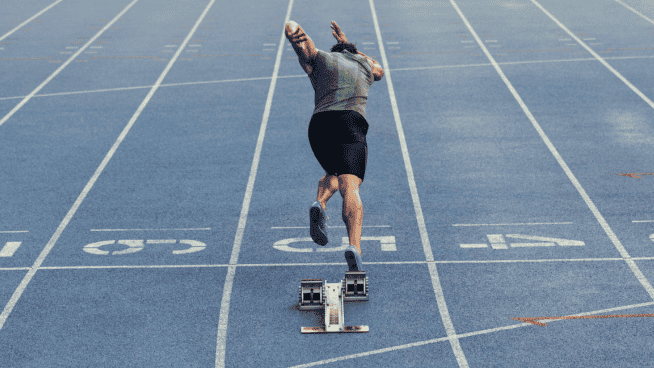The Most Important Muscles Your Workout Overlooks
You should be training your rear delts several times a week to improve your shoulder health. Ironically, they’re among the most neglected muscle groups in the body.
If you’re not familiar, the rear delts—technically the posterior deltoids—are the backside portion of the deltoid muscles, the round muscles that sit on your upper arms and shoulders. They help bring your upper arms behind your body and externally rotate your shoulders (hand turning outward).
In the image below, you can see the rear delts highlighted in yellow.
“The rear delts act as a main stabilizer when your elbows come parallel to or behind your body,” explains Rick Scarpulla, strength coach and owner of Ultimate Advantage Training. “They’re hugely important every time you throw, press or when your elbows comes toward your body.”
However, both athletes and regular gym-goers often fail to perform exercises that work their rear delts. And if they do rear delt exercises, they often perform them incorrectly.
Combine that with the fact that 99 percent of the people overtrain the front portion of their deltoids with pressing exercises such as the Bench Press and Push-Ups, and you have a recipe for weak and dysfunctional shoulders that are bound to present problems.
Here are some of the reasons why you need to make rear delt exercises a priority in your workouts.
Improved shoulder health and posture
Performing too many pressing exercises along with our tendency to sit in a forward hunched position can ruin our posture and create an overly dominant frontside of the body. This pulls the shoulders out of their ideal position and makes them more susceptible to pain or injury.
Hammering away on the rear delts helps reverse this by counteracting pressing exercises and pulling the shoulders back into position for improved posture.
Builds a bigger Bench Press
It may seem counterintuitive, but strong rear delts will lead to a bigger Bench Press, because the shoulders will be able to handle heavier loads.
“The rear delts may be the most overlooked portion of the Bench Press,” says Scarpulla. “It’s extremely important to have those rear stabilizers exceptionally strong to decelerate the bar as you bring it down to your chest.”
Controlling the deceleration of the bar will help you accelerate it off your chest with more speed, which ultimately helps you lift more weight.
Improved aesthetics
You’d be hard pressed to find someone who doesn’t want bigger shoulders—even among people who swear they train only for performance. Large rear delts help round out the shoulders to create the boulder-shoulder look that many of you are training, all while improving health and performance. So what’s not to like?
How to Properly Train Your Rear Delts
To put it simply, you need to train your rear delts—a lot.
The rear delts are considered postural muscles, meaning they’re constantly working to keep your posture in check and maintain shoulder stability. This makes them perfectly suited for handing frequent training sessions.
“Rear delts are a muscle group that doesn’t handle heavy weight all that great, but they do handle volume well and quickly recover,” asserts Scarpulla.
With this in mind, here are some tips on how to optimize your rear delt training:
-
The vast majority of rear delt exercises should be performed for 3-4 sets of 15-25 reps to effectively work the muscle. You can even do burnout sets of more than 50 reps on Face Pulls or Band Pull-Aparts.
-
Do 1-2 rear delt exercises every upper-body workout. If the workout happens to be press heavy, increase the number of sets or reps to help balance out the muscles worked.
-
You can work your rear delts more than once a day. For example, if you trained your upper body in the morning, do 100 Band Pull-Aparts at lunchtime for an additional strength effect.
-
Warm up your shoulders for the Bench Press with rear delt exercises, such as Dr. John Rusin’s banded shoulder warm-up routine. You can even superset rear delt exercises with the Bench Press or other pressing movements.
Now that you know how train your rear delts, here are some of the best exercises—many of which are provided courtesy of Rusin.
Band Pull-Aparts
[youtube video=”ra6PpeyKS6Q” /]How to: Stand with your feet hip-width apart and hold a resistance band with your palms down in front of your chest. Pull the band out to your sides and stretch it until your arms are parallel to your body.
Face Pulls
[youtube video=”h4YO9JzpQWo” /]How to: Attach a resistance band to a squat rack at eye level. Stand with your feet hip-width apart and hold the band (or band handles) with your palms down at eye level. Pull your hands backward until they’re next to your face.
Bent-Over Lateral Raises (Rear Delt Raises)
How to: Stand with your feet hip-width apart holding dumbbells in both hands at your sides. Bend at the waist and slightly bend your knees to lean over until your torso is nearly parallel to the ground. Your arms should hang below your shoulders with your elbows slightly bent. With your core tight and back flat, raise the dumbbells to the sides until your elbows are in line with your shoulders.
For detailed instructions, check out our comprehensive guide to the Bent-Over Lateral Raise.
Cable Reverse Fly
[youtube video=”f5V2XHVR3Dg” /]How to: Stand with your feet hip-width apart holding a cable handle in each hand with your arms straight in front of your shoulders and your palms facing in. Ideally, the cables should cross each other. Pull the cables outward to your sides until your arms are parallel to your body.
Prone Lateral Raise
[youtube video=”XIJTt_Czqmc” /]How to: Lie with your stomach on an incline bench, holding dumbbells directly under your shoulders with your palms facing in and elbows slightly bent. Raise the dumbbells to the sides until your elbows are in line with your shoulders.
RELATED:
RECOMMENDED FOR YOU
The Most Important Muscles Your Workout Overlooks
You should be training your rear delts several times a week to improve your shoulder health. Ironically, they’re among the most neglected muscle groups in the body.
If you’re not familiar, the rear delts—technically the posterior deltoids—are the backside portion of the deltoid muscles, the round muscles that sit on your upper arms and shoulders. They help bring your upper arms behind your body and externally rotate your shoulders (hand turning outward).
In the image below, you can see the rear delts highlighted in yellow.
“The rear delts act as a main stabilizer when your elbows come parallel to or behind your body,” explains Rick Scarpulla, strength coach and owner of Ultimate Advantage Training. “They’re hugely important every time you throw, press or when your elbows comes toward your body.”
However, both athletes and regular gym-goers often fail to perform exercises that work their rear delts. And if they do rear delt exercises, they often perform them incorrectly.
Combine that with the fact that 99 percent of the people overtrain the front portion of their deltoids with pressing exercises such as the Bench Press and Push-Ups, and you have a recipe for weak and dysfunctional shoulders that are bound to present problems.
Here are some of the reasons why you need to make rear delt exercises a priority in your workouts.
Improved shoulder health and posture
Performing too many pressing exercises along with our tendency to sit in a forward hunched position can ruin our posture and create an overly dominant frontside of the body. This pulls the shoulders out of their ideal position and makes them more susceptible to pain or injury.
Hammering away on the rear delts helps reverse this by counteracting pressing exercises and pulling the shoulders back into position for improved posture.
Builds a bigger Bench Press
It may seem counterintuitive, but strong rear delts will lead to a bigger Bench Press, because the shoulders will be able to handle heavier loads.
“The rear delts may be the most overlooked portion of the Bench Press,” says Scarpulla. “It’s extremely important to have those rear stabilizers exceptionally strong to decelerate the bar as you bring it down to your chest.”
Controlling the deceleration of the bar will help you accelerate it off your chest with more speed, which ultimately helps you lift more weight.
Improved aesthetics
You’d be hard pressed to find someone who doesn’t want bigger shoulders—even among people who swear they train only for performance. Large rear delts help round out the shoulders to create the boulder-shoulder look that many of you are training, all while improving health and performance. So what’s not to like?
How to Properly Train Your Rear Delts
To put it simply, you need to train your rear delts—a lot.
The rear delts are considered postural muscles, meaning they’re constantly working to keep your posture in check and maintain shoulder stability. This makes them perfectly suited for handing frequent training sessions.
“Rear delts are a muscle group that doesn’t handle heavy weight all that great, but they do handle volume well and quickly recover,” asserts Scarpulla.
With this in mind, here are some tips on how to optimize your rear delt training:
-
The vast majority of rear delt exercises should be performed for 3-4 sets of 15-25 reps to effectively work the muscle. You can even do burnout sets of more than 50 reps on Face Pulls or Band Pull-Aparts.
-
Do 1-2 rear delt exercises every upper-body workout. If the workout happens to be press heavy, increase the number of sets or reps to help balance out the muscles worked.
-
You can work your rear delts more than once a day. For example, if you trained your upper body in the morning, do 100 Band Pull-Aparts at lunchtime for an additional strength effect.
-
Warm up your shoulders for the Bench Press with rear delt exercises, such as Dr. John Rusin’s banded shoulder warm-up routine. You can even superset rear delt exercises with the Bench Press or other pressing movements.
Now that you know how train your rear delts, here are some of the best exercises—many of which are provided courtesy of Rusin.
Band Pull-Aparts
[youtube video=”ra6PpeyKS6Q” /]How to: Stand with your feet hip-width apart and hold a resistance band with your palms down in front of your chest. Pull the band out to your sides and stretch it until your arms are parallel to your body.
Face Pulls
[youtube video=”h4YO9JzpQWo” /]How to: Attach a resistance band to a squat rack at eye level. Stand with your feet hip-width apart and hold the band (or band handles) with your palms down at eye level. Pull your hands backward until they’re next to your face.
Bent-Over Lateral Raises (Rear Delt Raises)
How to: Stand with your feet hip-width apart holding dumbbells in both hands at your sides. Bend at the waist and slightly bend your knees to lean over until your torso is nearly parallel to the ground. Your arms should hang below your shoulders with your elbows slightly bent. With your core tight and back flat, raise the dumbbells to the sides until your elbows are in line with your shoulders.
For detailed instructions, check out our comprehensive guide to the Bent-Over Lateral Raise.
Cable Reverse Fly
[youtube video=”f5V2XHVR3Dg” /]How to: Stand with your feet hip-width apart holding a cable handle in each hand with your arms straight in front of your shoulders and your palms facing in. Ideally, the cables should cross each other. Pull the cables outward to your sides until your arms are parallel to your body.
Prone Lateral Raise
[youtube video=”XIJTt_Czqmc” /]How to: Lie with your stomach on an incline bench, holding dumbbells directly under your shoulders with your palms facing in and elbows slightly bent. Raise the dumbbells to the sides until your elbows are in line with your shoulders.
RELATED:











